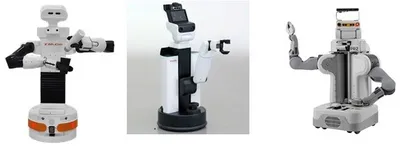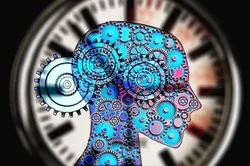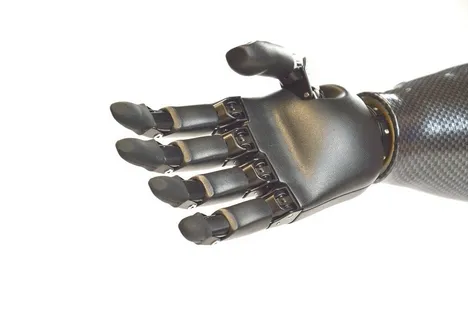Topics Advanced Seminar & Projektpraktikum
Due to the current situation, all topics for the Advanced Seminar and Projektpraktikum are listed here.
Please get in touch with contact person listed directly in the description of the topic to discuss any details or ask questions.
Advanced Seminar topics are listed here, Projektpraktikum topics are listed in the subpage.
(Updated August 2022)
Topics Advanced Seminar
Topic: SoA on Model Learning in Robot Control
Topic: SoA on Model Learning in Robot Control
Advisor: Simon Armleder
Description: The goal of this Hauptseminar is to explore the current state of the art in model learning in robot control.
Classical control approaches require accurate models of the robot and its environment. However, analytical models obtained from physics-based modeling techniques (e.g. Euler-Lagrange) cannot cope with changes in the robot’s dynamics or the environment.
Techniques such as Gaussian Process Regression, Locally weighted projection regression, or neural networks provide alternatives to determining a robot model from data.
Interesting questions:
- Pro/cons of different approaches in terms of data efficiency?
- Online adaptation or offline learning?
- Which transfer function is learned (forward kinematics, inverse kinematics, inverse dynamics, operational space control, …)?
- Is the learned model task-specific, can it be transferred?
- Is the approach learning residuals (difference analytical model vs real robot) or everything from scratch?
References:
[1] Gupta, Jayesh K., et al. "Structured mechanical models for robot learning and control." Learning for Dynamics and Control. PMLR, 2020.
[2] Peters, Jan, and Stefan Schaal. "Learning to control in operational space." The International Journal of Robotics Research 27.2 (2008): 197-212.
[3] Meier, Franziska, et al. "Towards robust online inverse dynamics learning." 2016 IEEE/RSJ International Conference on Intelligent Robots and Systems (IROS). IEEE, 2016.
[4] Nguyen-Tuong, Duy, and Jan Peters. "Model learning for robot control: a survey." Cognitive processing 12.4 (2011): 319-340.
[5] Bocsi, Botond, Lehel Csató, and Jan Peters. "Alignment-based transfer learning for robot models." The 2013 international joint conference on neural networks (IJCNN). IEEE, 2013

SoA on General control frameworks for service robots (mobile manipulators) and teleoperation
Advisor: Julio Rogelio Guadarrama Olvera
The classic architecture of service robots is a mobile base that carries one or two manimulators provided with a several sensors. While the potential applications is broad, the core functionality of them relies on the motion control. While the robot architectures are different from each other, the share common elements that make it feasible to develop general control frameworks that can be implemented on different platforms without the need of specific library generation. Some examples of these frameworks are the motion planner MoveIt and the ros_control framework.
References:
[1] Honerkamp, D., Welschehold, T., & Valada, A. (2021). Learning Kinematic Feasibility for Mobile Manipulation through Deep Reinforcement Learning. arXiv preprint arXiv:2101.05325.
[2] Mansard, N., Stasse, O., Evrard, P., & Kheddar, A. (2009, June). A versatile generalized inverted kinematics implementation for collaborative working humanoid robots: The stack of tasks. In 2009 International conference on advanced robotics (pp. 1-6). IEEE.
[3] Chitta, S., Sucan, I., & Cousins, S. (2012). Moveit![ros topics]. IEEE Robotics & Automation Magazine, 19(1), 18-19.
State of the art in walking controller software architectures
Advisor: Julio Rogelio Guadarrama Olvera
Biped and humanoid robots are complex systems that have gained popularity in recent decades. The tasks of keeping balance and walking require precise real-time implementations for estimating the robot state, generating walking trajectories, rejecting external disturbances, and navigating in static or changing scenarios. Such implementations can be found in open source projects and commercial software stacks that adapt to the needs of specific humanoid and biped robot models. The aim of this topic is to compare the latest implementations of walking controllers to find out their advantages and disadvantages for both small and human size robots.
References:
- Kajita, S., Hirukawa, H., Harada, K., & Yokoi, K. (2014). Introduction to humanoid robotics (Vol. 101, p. 2014). Springer Berlin Heidelberg.
- Natale, L., Asfour, T., Kanehiro, F., & Vahrenkamp, N. (Eds.). (2018). Software Architectures for Humanoid Robotics. Frontiers Media SA.
- Englsberger, J., Ott, C., & Albu-Schäffer, A. (2015). Three-dimensional bipedal walking control based on divergent component of motion. Ieee transactions on robotics, 31(2), 355-368.
- Caron, S., & Kheddar, A. (2016, November). Multi-contact walking pattern generation based on model preview control of 3d com accelerations. In 2016 IEEE-RAS 16th International Conference on Humanoid Robots (Humanoids) (pp. 550-557). IEEE.
State of the art of “Robocup(at)Home” and “World Robot Summit” solutions
Advisor: Julio Rogelio Guadarrama Olvera
The Robocup(at)Home competition is a world tournament on human service robotics solutions. It started as a side event of the Robo Cup football competition and has built its own community and enthusiasts over the years. Nowadays, there are several local leagues around the world that help improve the solutions under different conditions and challenges which are then tested in the world league. The aim of this topic is to find out how are implemented the solutions of the winner teams (1st, 2nd, and 3rd place) in the world and local leagues to help our team with fresh ideas. The research work will include both reading team description papers and open-source code when available.
References:
- http://www.robocupathome.org/
- https://www.robocupgermanopen.de/de/major/athome
- http://www.robocup.or.jp/japanopen2019/entry-68.html
- RoboCup@Home: Analysis and results of evolving competitions for domestic and service robots, Iocchi L., Holz D., Ruiz-del-Solar J. , Sugiura K. and van der Zant T. Artificial Intelligence, Volume 229, December 2015, Pages 258–281, DOI: http://dx.doi.org/10.1016/j.artint.2015.08.002
Topics already taken

Topic: SoA on Control Strategies for Upper-Limb Exoskeletons (already taken)
Advisor: Natalia Paredes Acuña
Description: Control strategies for upper-limb exoskeletons depend on their sensory input signals such as sEMG, joint positions, force sensors, and actuation systems (motors). However, due to the erratic nature of physiological signals like sEMG, the integration of different sensor modalities, and the muscle activity and size difference among users, novel control strategies implement machine learning algorithms to estimate the user’s voluntary motion. Furthermore, control strategies should adapt to the nature of the intended therapy strategy. This means that the selected control mode depends on the user target group, e.g., stroke survivors, the actuated muscles, e.g., biceps brachii for elbow flexion, and the therapy routine that needs to be executed, e.g., sets of repetitions with partial or no active movement from the user.
References:
[1] Proietti, T., Crocher, V., Roby-Brami, A., & Jarrasse, N. (2016). Upper-Limb Robotic Exoskeletons for Neurorehabilitation: A Review on Control Strategies. IEEE reviews in biomedical engineering, 9, 4–14. doi.org/10.1109/RBME.2016.2552201
[2] Desplenter, T., Zhou, Y., Edmonds, B. P., Lidka, M., Goldman, A., & Trejos, A. L. (2020). Rehabilitative and assistive wearable mechatronic upper-limb devices: A review. Journal of Rehabilitation and Assistive Technologies Engineering. doi.org/10.1177/2055668320917870

Causality in Artificial Cognitive Systems (already taken)
Advisor: Nicolas Berberich and Constantin Uhde
Classical supervised machine learning is focused on learning associations between variables. If two events or features are frequently observed together then observing one changes the likelihood of observing the other. For efficient action planning, a cognitive system is required to not only learn bidirectional associations but also which event causes the other event, such that it can perform the right interventions to reach its goal. This task falls under the topic of “causal inference” which gained popularity in the last years due to work by Judea Pearl, Joshua Bengio, Bernhard Schölkopf and others. The aim of this seminar project is to produce a synopsis of state-of-the-art research in causal learning for artificial cognitive systems and robotics.
References:
- David Vernon, “Artificial Cognitive Systems: A Primer”
-
Judea Pearl, “Causal Inference in Statistics: A Primer”

Sensors for Prosthetic Hands to Support Sensory Feedback (already taken)
Advisor: Nicolas Berberich
Abstract: The goal of this seminar project is to critically analyze state-of-the-art research on the development of sensors for prosthetic hands. A special focus should be put on which sensor modalities are included, where the sensors are placed on the prosthetic hand and how the measured sensor values are used for sensory feedback to the prosthesis user. Methodologically, it is furthermore important to review how the sensors are scientifically evaluated, e.g. through objective performance tests or subjective user feedback.
References:
- Jaemin Kim et al. “Stretchable silicon nanoribbon electronics for skin prosthesis”, Nature Communications, 2014
- Jacob Segil et al. ”Multi-modal prosthetic fingertip sensor with proximity, contact, and force localization capabilities”, Collaborative and Controllable Robotics for Biomedical and Industrial Applications – Research, 2019
- Ahmad Alhaddad et al. “Toward 3D printed prosthetic hands that can satisfy psychosocial needs: grasping force comparisons between a prosthetic hand and human hands”, International Conference on Social Robotics, 2017